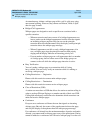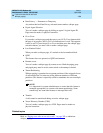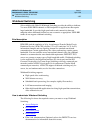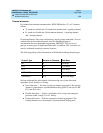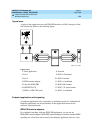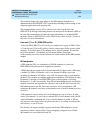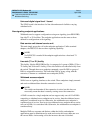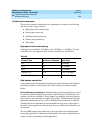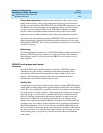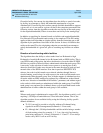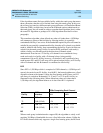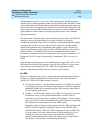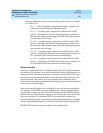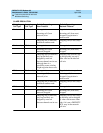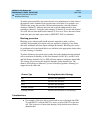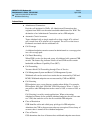
DEFINITY ECS Release 8.2
Administrator’s Guide
555-233-506
Issue 1
April 2000
Features and technical reference
1593Wideband Switching
20
Primary data connectivity. Permanent data connections (those always active
during business hours), such as interconnections between local area networks
(LANs), are well suited for DEFINITY ECS when ISDN-PRI endpoints are used.
The ISDN end-to-end monitoring and the endpoint’s ability to react to failures
provide for critical data availability needs. With ISDN, endpoints can detect
network failures and initiate backup connections through the switch; ISDN
endpoints can also establish additional calls when extra bandwidth is needed.
Any failures not automatically restored by DEFINITY ECS are signaled to the
endpoint application, which can initiate backup data connections over the same
PRI endpoint. DEFINITY ECS routes the backup data connections over alternate
facilities if necessary.
Networking
All of the wideband networking is over ISDN-PRI facilities (and the emulation of
them by ATM-CES) but may connect to a variety of networks, other domestic
interexchange carriers’ services, private line, RBOC services, and services in
other countries.
ISDN-PRI trunk groups and channel
allocation
Only ISDN-PRI trunks (and the emulation of them by ATM-CES) support
wideband calls to the network. Wideband’s bandwidth requirements have
necessitated modification of the algorithms by which trunks look for clear
channels. The following section describes the search methods and their
relationship to the available wideband data services.
Facility lists
A wideband call accessing the network must reside on a single ISDN-PRI facility.
Trunks within a trunk group must be organized based on the facility on which they
reside. This is accomplished by compiling a facility list as trunks are administered
to a trunk group; if a trunk is added to a trunk group from a facility not already on
that trunk group’s list, that facility is added to the list in an order based on the
facility’s signaling group number and interface identifier. In other words, the
facility list is compiled in an ascending order based first on signaling group
number and second on the interface identifier assigned to the facility within the
signaling group. For example, if three facilities having signaling group/interface
identifier combinations of 1/1, 1/2, and 2/1 were associated with a trunk group,
then a call offered to that trunk group would search those facilities in the order as
they were just listed. Also note that since trunks within a given facility can span
several trunk groups, a single facility can be associated with several different
trunk groups.



